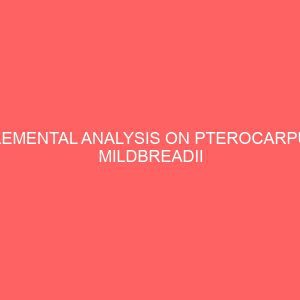PRELIMINARY INVESTIGATION ON EFFECTS OF BURANTASHI EXTRACT ON LIPOPROTEINS OF ALBINO MALE AND FEMALE WHISTAR RATS
ABSTRACT
This work was carried out to investigate the effects of Burrantashi extracts on the lipoproteins Burantashi is a popular seasoning agent to barbecued meat Suya in Nigeria. Found in the northern parts of the country. Lipoproteins are the principal steroid or fat that is synthesized in the liver or intestines of animals. Erectile dysfunction ED is defined as the consistent or recurrent inability of a man to attain or maintain penile erection, sufficient for sexual activity 2nd international consultation on sexual dysfunction Paris, June 28th July 1st 2003. Following the discovery and introduction of burantashi research on the mechanism underlying penile erection, had an enormous boost and many preclinical and clinical papers have been published in the last five years on the peripheral regulation of, and the mediators involved in human penile erection. The most widely accepted risk factors for e.g. are discussed. The research is focused on human data and the safety and effectiveness of burantashi stem as a phosphodiesterase 5 inhibitors PDEs used to treat erectile dysfunction.
CHAPTER ONE
INTRODUCTION
Erectile dysfunction, ED, is a sexual dysfunction that affects the reproductive systems of both men and women. By definition according to National Institute of Health consensus Development Panel on impotence 1993, in Males, it is a sexual dysfunction characterized with the inability to develop or maintain an erection of the penis sufficient for satisfactory sexual performance. It is also known as Male impotence or Baby D syndrome, while in women, according to American Psychiatric Association 1994, it is characterized with the persistent or recurrent inability to attain, or maintain until completion of the sexual activity, an adequate Lubrication Swelling response that otherwise is present during female sexual arousal and sexual activity is thus prevented. Hence, it is called Women impotence or female erectile dysfunction.
The word impotence may also be used to describe other problems that may interfere with sexual intercourse and reproduction, such as lack of Sexual Desire and problems with ejaculation or orgasm. Using the term erectile dysfunction, however makes it clear that those other problems are not involved NIH, 2005.
An erection occurs as a hydraulic effect due to blood entering and being retained in spongelike bodies within the penis and clitoris. The process is most often than not initiated as a result of sexual arousal, when signals are transmitted from the brain to nerves in the pelvis.
Erectile dysfunction is, therefore indicated when an erection is consistently difficult or impossible to produce, despite arousal Laumann et al., 1999.
1.1 PREVALENCE OF ERECTILE DYSFUNCTION IN WOMEN
Erectile dysfunction which is known as Female erection dysfunction in women occurs in about 43 of American Women NIH Consensus Conference, 1993. And this medical Condition is a persistent or recurrent inability to attain or maintain clitoral erection until completion of the sexual activity, an adequate Lubrication Swelling response that is normally present during Female sexual arousal and sexual activity is therefore, absent. The individual having the condition is said to experience frigidity American Psychiatric Association, 1994. Again,
According to Otubu et al. 1998 about 8.7 of Women suffer from this very condition in the United States while between 35.3 40, according to Adequnloye 2002 and Eze 1994 of Women in Nigeria suffer from this condition. Spector and Carey 1994 reported 510 in the United States.
In addition, Female erectile dysfunction occurs at any age but majorly in old age. Hence, the most significant age related change is menopause Karen, 2000 and Rod et al., 2005. However, erectile dysfunction may be caused by diabetes, atherosclerosis, hormonal imbalances, neurological problems etc. Organic causes or stress, depression etc.
Because treating the underlying causes Organic or Psychological, the first line treatment of ED consists of a trial of PDES inhibitor the first of which was Sildenafil or Viagra. In some cases, treatment can involve prostagLandin tablets in the Urethra, intravenous injection with a fine needle into the penis or clitoris that causes swelling of Penis or Clitoris Pump or Vascular surgery, estrogen replacement therapy for the women etc.
Although there are various methods and techniques that are used to treat this very condition, however, for the purpose of this project, the treatment is restricted to Yohimbe, an extract from Pausinystalia yohimbe.
1.2 PREVALENCE OF ERECTILE DYSFUNCTION IN MEN
Erectile dysfunction, ED, varies in severity; some men have a total inability to achieve an erection, others have inconsistent ability to achieve an erection, and still others can sustain only brief erection. The variation in severity of erectile dysfunction makes estimating its frequency difficult.
Many men also are reluctant to discuss erectile dysfunction with their doctors, and thus, the condition is underdiagnosed. Nevertheless, experts have estimated that ED affects 30 million men in the United States. Again, according to the statistical research carried out by Adegunloye 2002 and Eze 1994 respectively in Nigeria, results shows that about 2326.4 of men suffer from this condition while according to Spector and Carey 1999 discovered that about 49 of men suffer from the condition in the United States.
While erectile dysfunction can occur at any age, it is uncommon among young men and more common in the elderly. By the age of 45, most men have experienced erectile dysfunction at least some of the time. According to the Massachusetts Male Aging Study, complete impotence increases from 5 among Men 40 years of age to 15 among Men 70 years and older. Population studies conducted in the Netherlands found out that some degree of ED occurred in 20 of Men between 50 54 and in 50 of men between ages 70 78. In 1998, the National Ambulatory Medical care Survey counted 1,520,000 Doctor Offices visited for ED.
1.3 OBJECTIVE STUDY AND AIMS
This project focuses to give a clear picture of the effect on erectile tissues of the Penis, Clitoris of both Men and Women.
1.4 NITRIC OXIDECYCLIC GMP PATHWAY WITH SOME EMPHASIS ON CAVERNOSAL CONTRACTILITY
Nitric Oxide NO is formed from the conversion of L arginine by nitric oxide synthase NOS, endothelial eNOS, and inducible iNOS. nNOS is expressed in penile neurons innervating the corpus Cavernosum, and eNOS protein expression has been identified primarily in both Cavernosal Smooth Muscle and endothelium. NO is released from nerve endings and endothelial cells and stimulates the activity of soluble guanylate cyclase sGC, leading to an increase in cyclic guanosine 3,5, Monophosphate cGMP and, finally, to Calcuim depletion from the cytosolic space and Cavernous Smooth muscle relaxation. The effect of cGMP are mediated by cGMP dependent Protein Kinase, cGMPgated ion channels, and cGMPregulated Phosphodiesterases PDE. Thus, cGMP effect depends on the expression of a CellSpecific cGMPreceptor protein in a given cell type. Numerous systemic vasculature diseases that cause erectile dysfunction ED are highly associated with endothelial dysfunction, which has been shown to contribute to decrease erectile function in men and a number of animal models of penile erection. Based on the increasing knowledge of intracellular signal propagation in cavernous smooth muscle tone regulation, selective PDE inhibitors have recently been introduced in the treatment of ED. Phosphodiesterase5 PDE5 inactivates cGMP, which terminates NOcGMPmediated SMooth Muscle relaxation. Inhibition of PDE5 is expected to enhance penile erection by preventing cGMP degradation. Development of pharmacologic agents with this effect has closely paralleled the emerging science.
International Journal of impotence Research 2004. Nitric oxide NO was first described by Stuehr and Marletta 1985 as a product of activated murine machrophages. Also, the substance known as endothelium derived relaxing factor EDRF, described by Furchgott and Zawadzki 1980, has been identified as NO.
Soluble guanylate cyclase sGC, responsible for the enzymatic conversion of guanosine 5 triphosphate GTP to cyclic guanosine 35 monophosphate cGMP, was first identified as a constituent of mammalian cells almost three decades ago. No and cGMP together comprise an especially wideranging signals transduction system when one considers the many roles of cGMP in physiological regulation, including smooth muscle relaxation, visual transduction, intestinal ion transport, and platelet function.
Erectile dysfunction ED is defined as the constituent inability to achieve or maintain an erection sufficient for satisfactory sexual performance and is considered to be a natural process of ageing. Studies have shown that ED is caused by inadequate relaxing of the corpus cavernosum with defeat in NO production.
It is clear that NO is the predominant neurotransmitter responsible for cavernasal Smooth muscle relaxation and hence penile erection. Its action is medicated through the generation of the second messenger cGMP. Neutrally, derived NO has been established as a mediator of smooth muscle relaxation in the penis and it is thought that constitutive forms of nitric oxide synthase NOS work to mediate the convesion of GTP to the intracellular second messenger cGMP in smooth muscle cells. An increase in cGMP modulates cellular events, such as relaxation of smooth muscle cells.
This review will describe current knowledge of cellular events involved in cavernosal relaxation and the range of putative factors involved in NOmediated relaxation.
1.5 SYNTHESIS OF Nitric Oxide NO.
Recent observation suggest that the main site of NO biosythesis in human corpus cavernosum is within the terminal branches of cavernosal
nerves supplying the erectile tissue. It is strongly suggested that NO released from nonadrenergic noncholinergic NANC neurons increases the production of cGMP, which in turn relaxes the cavernous smooth muscle. Endothelial derived NO plays a major role in the penis. Some suggest that NO is highly labile, therefore it cannot be stored as a preformed neurotransmitter. Other proerectile mediators, such as acetylcholine, calcitonin gene related peptide CGRP or substance P, act via endothelialcells by prompting the synthesis and release of NO by these cells, Bivalacqua et al., 2001. Found in their study that in vivo adenoviral gene transfer of CGRP in combination with adrenomedullin ADM or prostaglandin E1PGEI induce penile erection by activating different receptors.
The combination of molecular oxygen and the amino acid arginine in the presence of reduced nicotinamide adenine dinucleotide phosphate NADPH and NO synthase, NOS yields citruline nitrogen of L arginine. L citrulline can be converted by arginine synthase AS to form Larginine, the precursor for NO. Each of these enzymes, cofactors, or transport systems could be an eventual target of pharmacologic intervention in the NO cascade.
Oral administration of Larginine in high doses seems to cause significant subjective improvement in sexual function in men with Organic ED only if they have decreased production of plasma and urine nitrite and nitrates, which are stable metabolites of NO. There are at least three isoform of NOS neuronal, endothelial, and macrophage. A constitutive form of NOS is found in endothelial and neurons, and is calcium dependent. The constitutive NOS3, whereas the constitute NOS found in neutral and epithelial tissue has been named NOS1. An inducible form of NOS, now designated iNOS, is calcium independent. It is induced within 424h of the appropriate stimulus and can produce NO in a 100fold greater amount than can constitutive NOS.
Neutral NOS has multiple regulator sites, including binding sites for nicotinamide adenine dinucleotide phosphate NADPH, Flavin adenine dinucleotide FAD, and flavin Monoucleotide FMN. All of these are O factors for the synthesis of NO. these cofactors bind to a reductase domain to process election transfer. This is then linked to heme and tetrahydrobiopterin BH4 containing catalytic oxygenenase domain by calciumcalmodulin complex figure 2.
The complete enzyme converts Larginine to L citrulline and NO in the presence of molecular Oxygen. In addition to the various protein modules or domains of neuronal NOS, which are involved in electron transfer, substrate binding, oxygen activation and calcium binding, a four amino acid motif glycine Leucineglycine Phenylalanine, GLGF has been identified in amino terminal region of NOS1. Although the function of this aminoacid motif in NOS2 has not been established, a study on other proteins containing this motif indicates that it may serve to target proteins to specific sites in the cell. nNOS has a recognition site for calmodulin that is also present in eNOS and macrophages NOS. The constitutive isoforms are generally regulated by Ca2 calmodulin, whereas inducible forms are not.
nNOS in the penis is expressed primarily as a variant of the brain form of nNOS and has been termed PnNOS. It has an additional 102bp alternative exon located between exons 16 and 17. The function of this additional coding region is unknown. PnNOS is thought to be responsible for trigging the nitregic mechanism responsible for cavernosal relaxation. A similar variant, nNOSU is present in the neuromuscular plates of skeletal muscles, including the perineal muscles involved in erectile rigidity and ejaculation in rats. The control of NO synthesis in the Cavernosal nerve, whether due to sexual stimulation emanating.
Centrally, from the brain, or peripherally by means of the dorsal nerve spinal reflex is assumed to be exerted through the activation of PnNOS activity. This mechanism occurs mainly by Ca2 binding to calmodulin by means of Ca2 flux through the NmethylDaspartate receptor NMDAR. Both the NMDAR and inhibitors of nNOS activity, such as protein inhibitors of nNOS activity, such as protein inhibitors of NOSPIN and carboxy terminal POZ Ligand of nNOS CAPON, also bind to nNOS .
The nitrognic activation of penile erection is not restricted to peripheral nerves of the corpora cavernosa but is also dependent on central nervous system CNS regulated.
1.6 INACTIVATION
NO is inactivated by heme and the free radical, superoxide .thus scavengers of superoxide anion such as superoxide dismutase SOD may protect NO, enhancing its potency and prolong its duration of action. Conversely, interaction of NO with super oxide may generate the potent tissue damaging moiety, peroxynitrite ON001, which has a high affinity for sulfhydryl groups and thus inactives several key sulphydrylbearing enzymes. This effect of perotynitrite is regulated by the cellular content of glutathione.
Khan et al., 2001 found that NO and electrical field stimulated EFS mediated cavernosal smooth muscle relaxation is impaired in a rabbit of diabetes but SOD significantly reversed the impaired relaxation. Manipulation of physiological NO concentration is unlikely to give physiological benefits in ED, since higher levels will predispose to toxic effects NO availability may be increased by the use of the enzyme superoxide dismutase SOD, which causes decreased levels of superoxide anion.
1.7 The NO receptor: Soluble guanylate cyclase
Soluble GC is a heme containing protein found in the cytosolic fraction of virualy all mammalian cells. With the highest concentrations found in the lungs and brain. Several isoforms of sGC have been Cloned and characterized. Originally sGC was purified to apparent homogeiniety from bovine and rat lung and shown to exist as a heterodimer, consisting of 82
Koa rat or 73Koa bovine and 70Koasubunits, termed x, and 1respectively. Further subunits termed x1 and 2 have also been identified from the human foetal brain 82Koa and rat kidney 76Koa, respectively, GUCIA2; the gene coding for the x2Subunit,has been localized to position q21q22 on the human chromosome 11.
Soluble GC is a heterodimer with at least three functional domains for each subunit figure 3. These domains are a heme binding domain, dimerization domain, and catalytic domain. The N terminal portion of each subunit constitutes a hemebinding domainand represents the least conserved region of the protein; it is the heme moiety that confers the NOsensitivity of the enzyme. Heme reconstituted more NO sensitive than an equivalent protein containing 1 mole heme per dimmer.
1.8 Intracellular cyclic GMP receptor proteins
Cyclic GMP interacts with three types of intracellular receptor proteins: cGMPdependent protein kinases PKGs, cGMPregulated ion channels and cGMPregulated cyclic nucleotide phosphodiesterases PDEs.
This means that cGMP alter cell function through mechanism not directly related to protein phosphorylation.
Two general classes of cGMP kinases exist in vertebrate cells: a type 1 and a type 11 form. The type 1 cGMP kinase is more abundant and widely distributed and has been isolated from vascular and other tissues while the ype 11 form has been detected in vertebrate intestinal epithelial cells.
Original price was: ₦3,200.00.₦3,000.00Current price is: ₦3,000.00.








Reviews
There are no reviews yet.